Impacts of Training and Development on Employee Performance Study
VerifiedAdded on 2022/10/01
|11
|2744
|17
Report
AI Summary
This research proposal outlines a study investigating the impacts of training and development on employee performance within the Malaysian banking sector. The research aims to evaluate the relationship between on-the-job training, off-the-job training, and job rotation on employee performance. It employs a positivism research philosophy with a deductive approach, utilizing a quantitative research method through questionnaires distributed to 100 employees. The proposal includes a literature review with an annotated bibliography of relevant studies, a detailed research methodology, data collection and analysis plans, ethical considerations, and a project timeline. The study seeks to provide recommendations for improving employee performance through effective training and development programs, contributing to the existing body of knowledge in human resource management and organizational behavior.
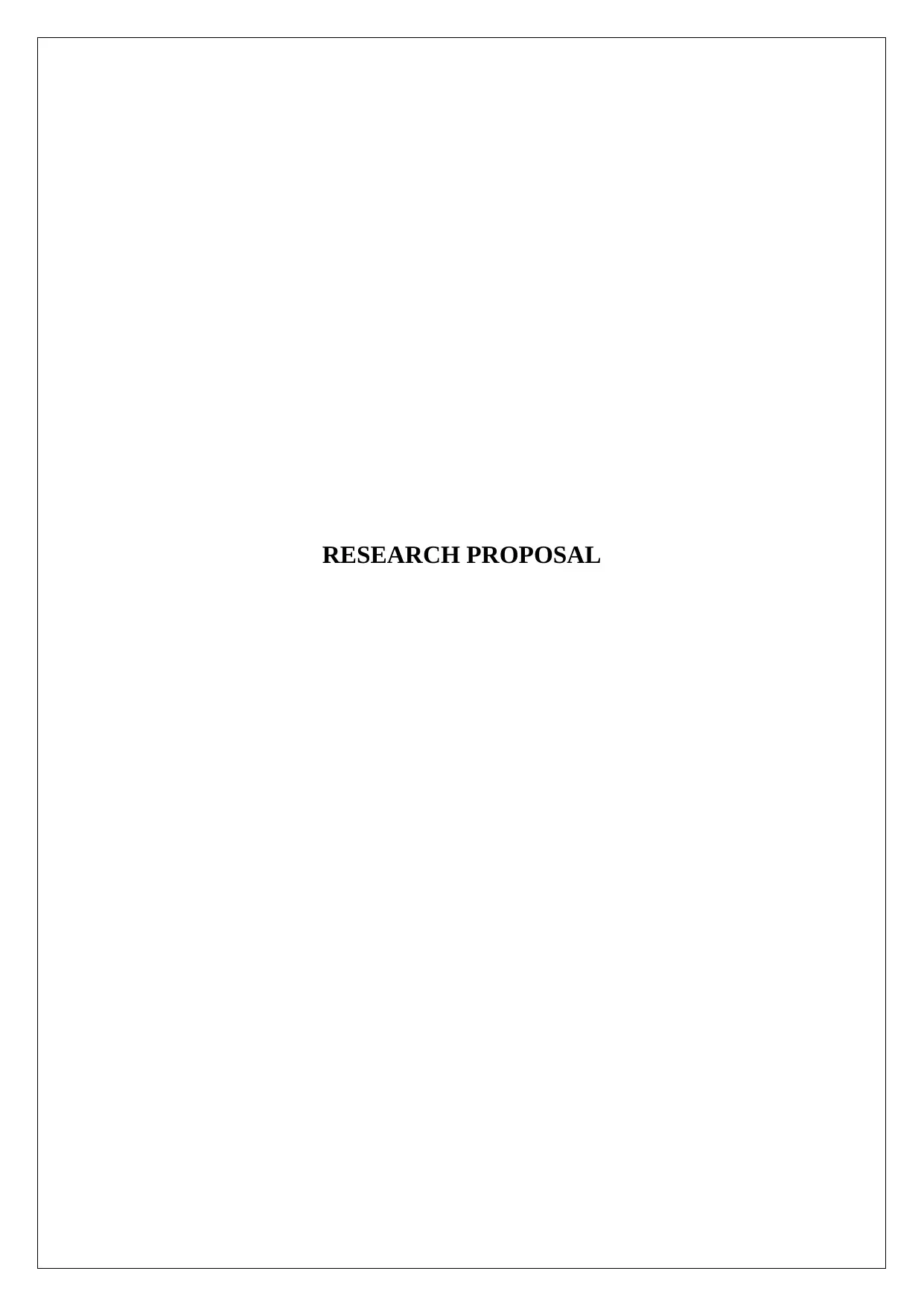
RESEARCH PROPOSAL
Paraphrase This Document
Need a fresh take? Get an instant paraphrase of this document with our AI Paraphraser

Table of Contents
Working title of the dissertation.................................................................................................3
Aim of the research....................................................................................................................3
Objectives...................................................................................................................................3
Introduction................................................................................................................................3
Literature search and overview..................................................................................................4
Annotated bibliography..........................................................................................................4
Research method and design......................................................................................................6
Research paradigm.................................................................................................................6
Data collection and sampling.................................................................................................6
Data analysis...........................................................................................................................6
Ethical consideration..............................................................................................................7
Plan of the project......................................................................................................................7
Reference list..............................................................................................................................9
List of literature........................................................................................................................10
2
Working title of the dissertation.................................................................................................3
Aim of the research....................................................................................................................3
Objectives...................................................................................................................................3
Introduction................................................................................................................................3
Literature search and overview..................................................................................................4
Annotated bibliography..........................................................................................................4
Research method and design......................................................................................................6
Research paradigm.................................................................................................................6
Data collection and sampling.................................................................................................6
Data analysis...........................................................................................................................6
Ethical consideration..............................................................................................................7
Plan of the project......................................................................................................................7
Reference list..............................................................................................................................9
List of literature........................................................................................................................10
2
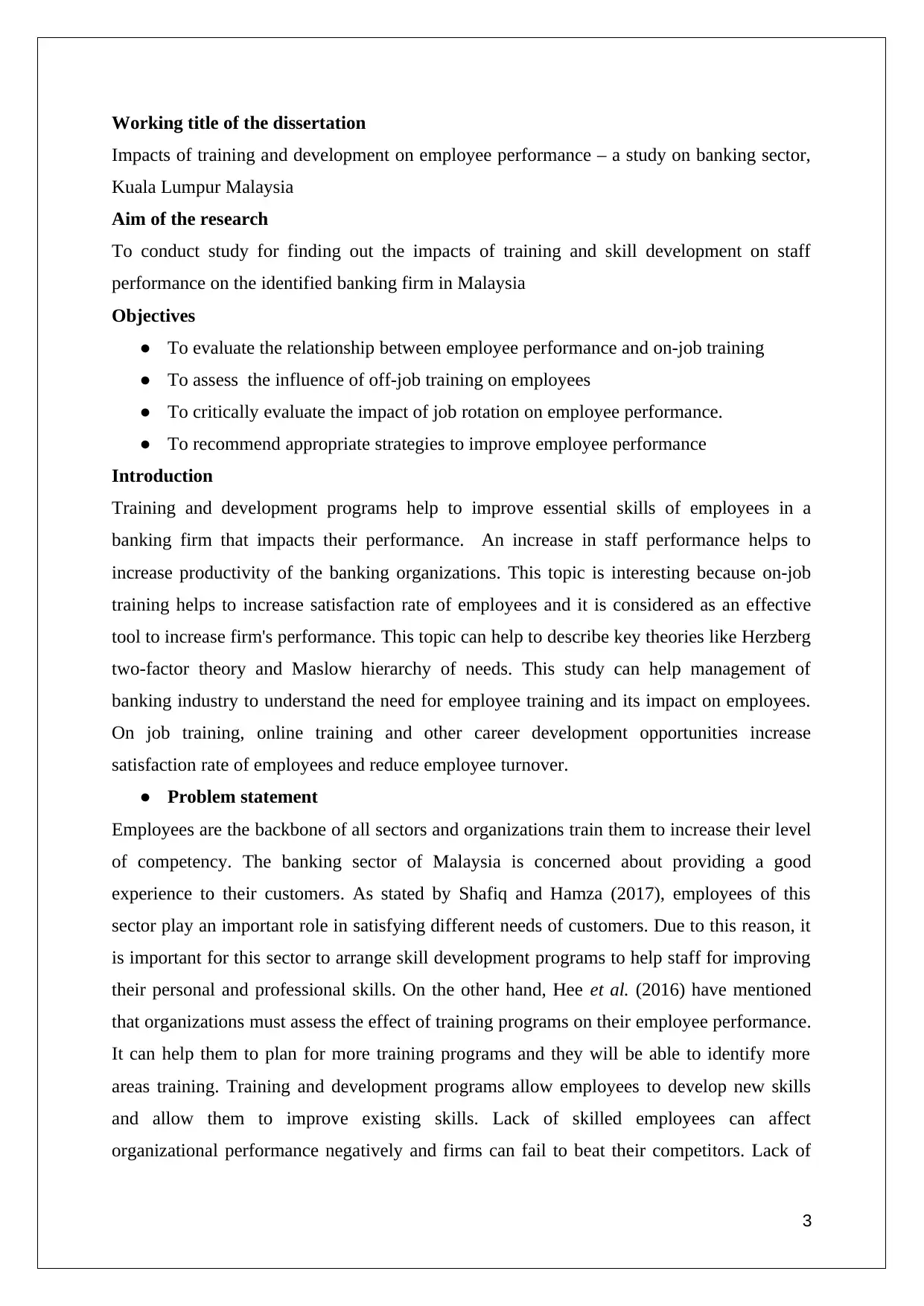
Working title of the dissertation
Impacts of training and development on employee performance – a study on banking sector,
Kuala Lumpur Malaysia
Aim of the research
To conduct study for finding out the impacts of training and skill development on staff
performance on the identified banking firm in Malaysia
Objectives
● To evaluate the relationship between employee performance and on-job training
● To assess the influence of off-job training on employees
● To critically evaluate the impact of job rotation on employee performance.
● To recommend appropriate strategies to improve employee performance
Introduction
Training and development programs help to improve essential skills of employees in a
banking firm that impacts their performance. An increase in staff performance helps to
increase productivity of the banking organizations. This topic is interesting because on-job
training helps to increase satisfaction rate of employees and it is considered as an effective
tool to increase firm's performance. This topic can help to describe key theories like Herzberg
two-factor theory and Maslow hierarchy of needs. This study can help management of
banking industry to understand the need for employee training and its impact on employees.
On job training, online training and other career development opportunities increase
satisfaction rate of employees and reduce employee turnover.
● Problem statement
Employees are the backbone of all sectors and organizations train them to increase their level
of competency. The banking sector of Malaysia is concerned about providing a good
experience to their customers. As stated by Shafiq and Hamza (2017), employees of this
sector play an important role in satisfying different needs of customers. Due to this reason, it
is important for this sector to arrange skill development programs to help staff for improving
their personal and professional skills. On the other hand, Hee et al. (2016) have mentioned
that organizations must assess the effect of training programs on their employee performance.
It can help them to plan for more training programs and they will be able to identify more
areas training. Training and development programs allow employees to develop new skills
and allow them to improve existing skills. Lack of skilled employees can affect
organizational performance negatively and firms can fail to beat their competitors. Lack of
3
Impacts of training and development on employee performance – a study on banking sector,
Kuala Lumpur Malaysia
Aim of the research
To conduct study for finding out the impacts of training and skill development on staff
performance on the identified banking firm in Malaysia
Objectives
● To evaluate the relationship between employee performance and on-job training
● To assess the influence of off-job training on employees
● To critically evaluate the impact of job rotation on employee performance.
● To recommend appropriate strategies to improve employee performance
Introduction
Training and development programs help to improve essential skills of employees in a
banking firm that impacts their performance. An increase in staff performance helps to
increase productivity of the banking organizations. This topic is interesting because on-job
training helps to increase satisfaction rate of employees and it is considered as an effective
tool to increase firm's performance. This topic can help to describe key theories like Herzberg
two-factor theory and Maslow hierarchy of needs. This study can help management of
banking industry to understand the need for employee training and its impact on employees.
On job training, online training and other career development opportunities increase
satisfaction rate of employees and reduce employee turnover.
● Problem statement
Employees are the backbone of all sectors and organizations train them to increase their level
of competency. The banking sector of Malaysia is concerned about providing a good
experience to their customers. As stated by Shafiq and Hamza (2017), employees of this
sector play an important role in satisfying different needs of customers. Due to this reason, it
is important for this sector to arrange skill development programs to help staff for improving
their personal and professional skills. On the other hand, Hee et al. (2016) have mentioned
that organizations must assess the effect of training programs on their employee performance.
It can help them to plan for more training programs and they will be able to identify more
areas training. Training and development programs allow employees to develop new skills
and allow them to improve existing skills. Lack of skilled employees can affect
organizational performance negatively and firms can fail to beat their competitors. Lack of
3
⊘ This is a preview!⊘
Do you want full access?
Subscribe today to unlock all pages.

Trusted by 1+ million students worldwide
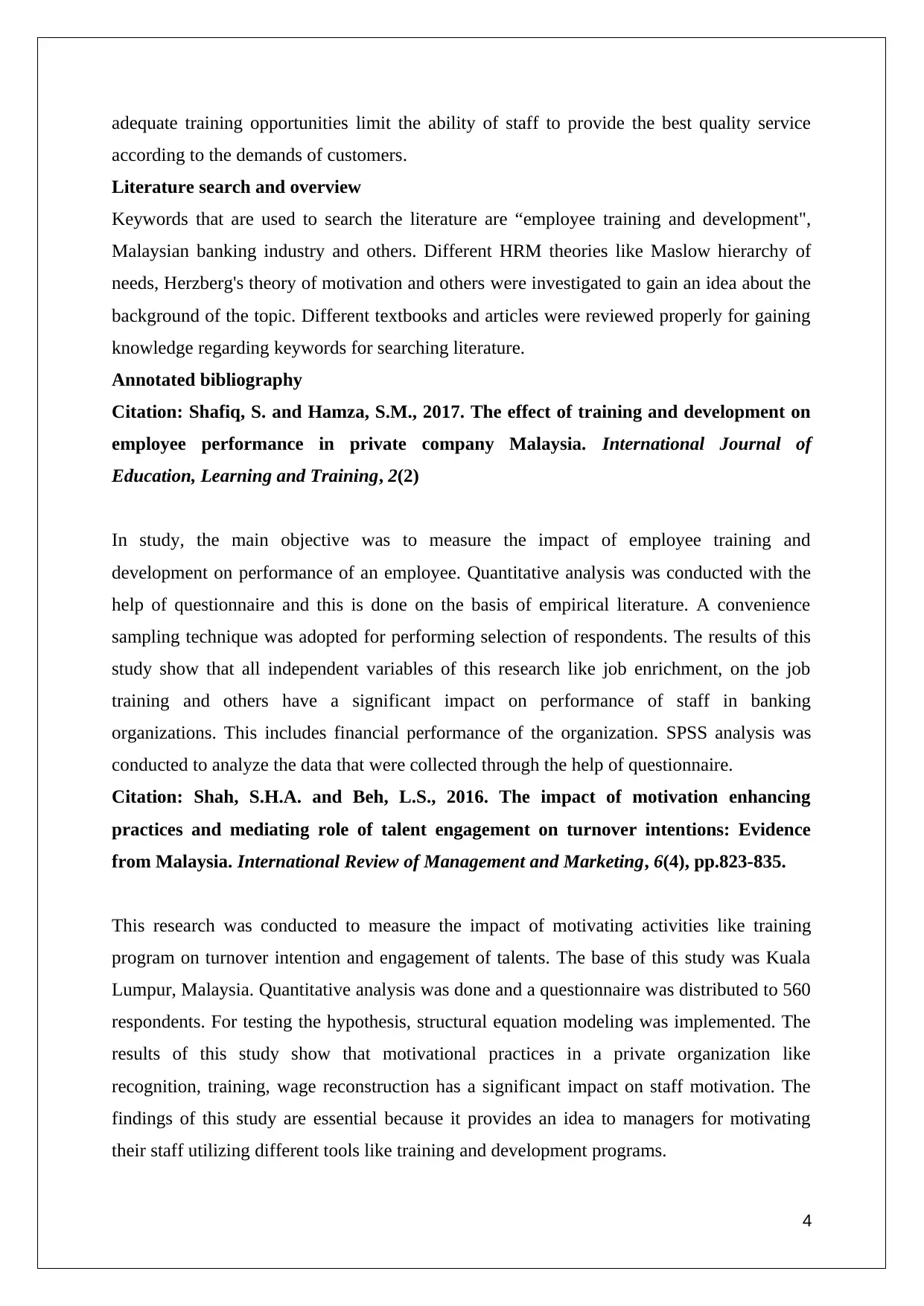
adequate training opportunities limit the ability of staff to provide the best quality service
according to the demands of customers.
Literature search and overview
Keywords that are used to search the literature are “employee training and development",
Malaysian banking industry and others. Different HRM theories like Maslow hierarchy of
needs, Herzberg's theory of motivation and others were investigated to gain an idea about the
background of the topic. Different textbooks and articles were reviewed properly for gaining
knowledge regarding keywords for searching literature.
Annotated bibliography
Citation: Shafiq, S. and Hamza, S.M., 2017. The effect of training and development on
employee performance in private company Malaysia. International Journal of
Education, Learning and Training, 2(2)
In study, the main objective was to measure the impact of employee training and
development on performance of an employee. Quantitative analysis was conducted with the
help of questionnaire and this is done on the basis of empirical literature. A convenience
sampling technique was adopted for performing selection of respondents. The results of this
study show that all independent variables of this research like job enrichment, on the job
training and others have a significant impact on performance of staff in banking
organizations. This includes financial performance of the organization. SPSS analysis was
conducted to analyze the data that were collected through the help of questionnaire.
Citation: Shah, S.H.A. and Beh, L.S., 2016. The impact of motivation enhancing
practices and mediating role of talent engagement on turnover intentions: Evidence
from Malaysia. International Review of Management and Marketing, 6(4), pp.823-835.
This research was conducted to measure the impact of motivating activities like training
program on turnover intention and engagement of talents. The base of this study was Kuala
Lumpur, Malaysia. Quantitative analysis was done and a questionnaire was distributed to 560
respondents. For testing the hypothesis, structural equation modeling was implemented. The
results of this study show that motivational practices in a private organization like
recognition, training, wage reconstruction has a significant impact on staff motivation. The
findings of this study are essential because it provides an idea to managers for motivating
their staff utilizing different tools like training and development programs.
4
according to the demands of customers.
Literature search and overview
Keywords that are used to search the literature are “employee training and development",
Malaysian banking industry and others. Different HRM theories like Maslow hierarchy of
needs, Herzberg's theory of motivation and others were investigated to gain an idea about the
background of the topic. Different textbooks and articles were reviewed properly for gaining
knowledge regarding keywords for searching literature.
Annotated bibliography
Citation: Shafiq, S. and Hamza, S.M., 2017. The effect of training and development on
employee performance in private company Malaysia. International Journal of
Education, Learning and Training, 2(2)
In study, the main objective was to measure the impact of employee training and
development on performance of an employee. Quantitative analysis was conducted with the
help of questionnaire and this is done on the basis of empirical literature. A convenience
sampling technique was adopted for performing selection of respondents. The results of this
study show that all independent variables of this research like job enrichment, on the job
training and others have a significant impact on performance of staff in banking
organizations. This includes financial performance of the organization. SPSS analysis was
conducted to analyze the data that were collected through the help of questionnaire.
Citation: Shah, S.H.A. and Beh, L.S., 2016. The impact of motivation enhancing
practices and mediating role of talent engagement on turnover intentions: Evidence
from Malaysia. International Review of Management and Marketing, 6(4), pp.823-835.
This research was conducted to measure the impact of motivating activities like training
program on turnover intention and engagement of talents. The base of this study was Kuala
Lumpur, Malaysia. Quantitative analysis was done and a questionnaire was distributed to 560
respondents. For testing the hypothesis, structural equation modeling was implemented. The
results of this study show that motivational practices in a private organization like
recognition, training, wage reconstruction has a significant impact on staff motivation. The
findings of this study are essential because it provides an idea to managers for motivating
their staff utilizing different tools like training and development programs.
4
Paraphrase This Document
Need a fresh take? Get an instant paraphrase of this document with our AI Paraphraser
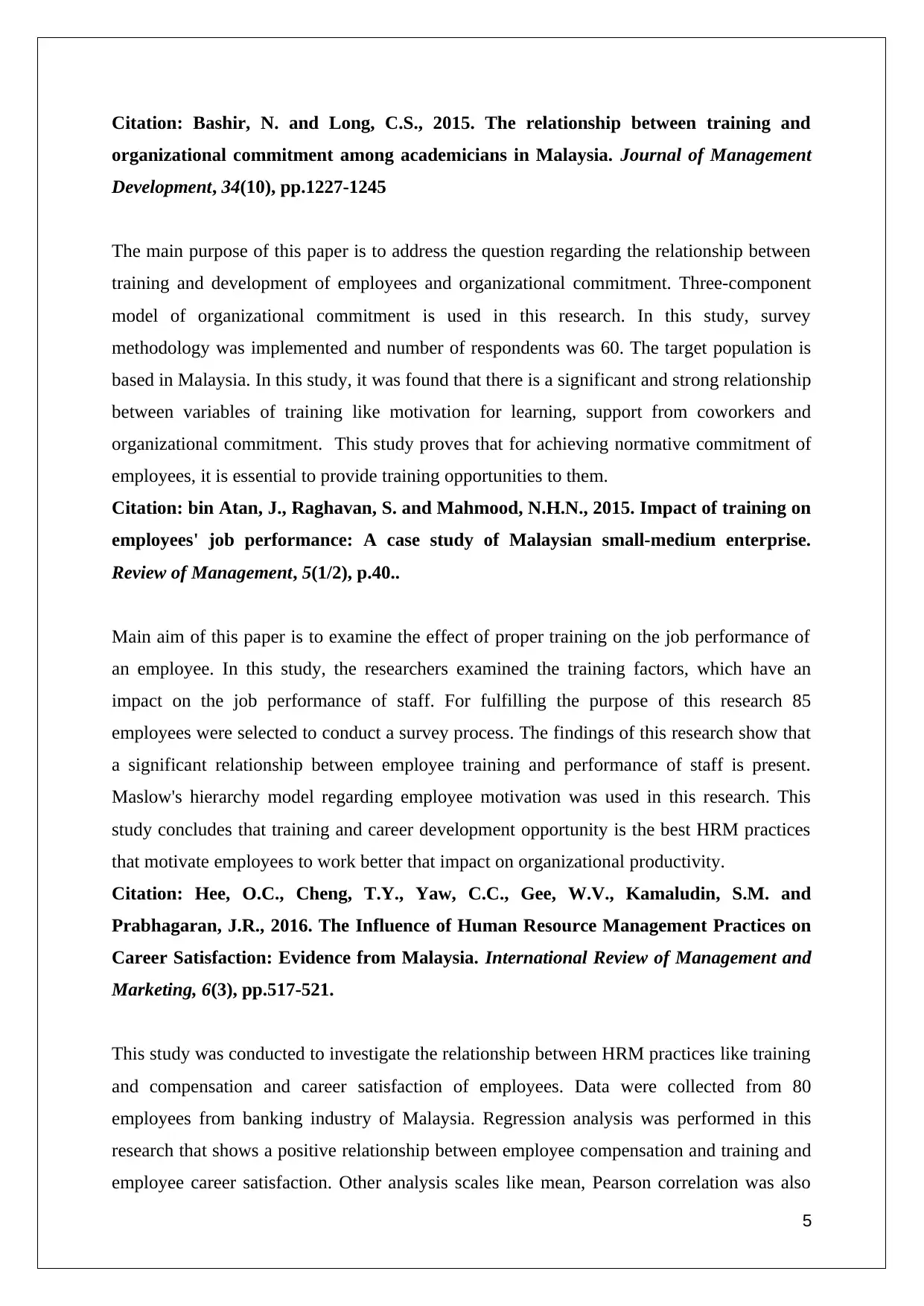
Citation: Bashir, N. and Long, C.S., 2015. The relationship between training and
organizational commitment among academicians in Malaysia. Journal of Management
Development, 34(10), pp.1227-1245
The main purpose of this paper is to address the question regarding the relationship between
training and development of employees and organizational commitment. Three-component
model of organizational commitment is used in this research. In this study, survey
methodology was implemented and number of respondents was 60. The target population is
based in Malaysia. In this study, it was found that there is a significant and strong relationship
between variables of training like motivation for learning, support from coworkers and
organizational commitment. This study proves that for achieving normative commitment of
employees, it is essential to provide training opportunities to them.
Citation: bin Atan, J., Raghavan, S. and Mahmood, N.H.N., 2015. Impact of training on
employees' job performance: A case study of Malaysian small-medium enterprise.
Review of Management, 5(1/2), p.40..
Main aim of this paper is to examine the effect of proper training on the job performance of
an employee. In this study, the researchers examined the training factors, which have an
impact on the job performance of staff. For fulfilling the purpose of this research 85
employees were selected to conduct a survey process. The findings of this research show that
a significant relationship between employee training and performance of staff is present.
Maslow's hierarchy model regarding employee motivation was used in this research. This
study concludes that training and career development opportunity is the best HRM practices
that motivate employees to work better that impact on organizational productivity.
Citation: Hee, O.C., Cheng, T.Y., Yaw, C.C., Gee, W.V., Kamaludin, S.M. and
Prabhagaran, J.R., 2016. The Influence of Human Resource Management Practices on
Career Satisfaction: Evidence from Malaysia. International Review of Management and
Marketing, 6(3), pp.517-521.
This study was conducted to investigate the relationship between HRM practices like training
and compensation and career satisfaction of employees. Data were collected from 80
employees from banking industry of Malaysia. Regression analysis was performed in this
research that shows a positive relationship between employee compensation and training and
employee career satisfaction. Other analysis scales like mean, Pearson correlation was also
5
organizational commitment among academicians in Malaysia. Journal of Management
Development, 34(10), pp.1227-1245
The main purpose of this paper is to address the question regarding the relationship between
training and development of employees and organizational commitment. Three-component
model of organizational commitment is used in this research. In this study, survey
methodology was implemented and number of respondents was 60. The target population is
based in Malaysia. In this study, it was found that there is a significant and strong relationship
between variables of training like motivation for learning, support from coworkers and
organizational commitment. This study proves that for achieving normative commitment of
employees, it is essential to provide training opportunities to them.
Citation: bin Atan, J., Raghavan, S. and Mahmood, N.H.N., 2015. Impact of training on
employees' job performance: A case study of Malaysian small-medium enterprise.
Review of Management, 5(1/2), p.40..
Main aim of this paper is to examine the effect of proper training on the job performance of
an employee. In this study, the researchers examined the training factors, which have an
impact on the job performance of staff. For fulfilling the purpose of this research 85
employees were selected to conduct a survey process. The findings of this research show that
a significant relationship between employee training and performance of staff is present.
Maslow's hierarchy model regarding employee motivation was used in this research. This
study concludes that training and career development opportunity is the best HRM practices
that motivate employees to work better that impact on organizational productivity.
Citation: Hee, O.C., Cheng, T.Y., Yaw, C.C., Gee, W.V., Kamaludin, S.M. and
Prabhagaran, J.R., 2016. The Influence of Human Resource Management Practices on
Career Satisfaction: Evidence from Malaysia. International Review of Management and
Marketing, 6(3), pp.517-521.
This study was conducted to investigate the relationship between HRM practices like training
and compensation and career satisfaction of employees. Data were collected from 80
employees from banking industry of Malaysia. Regression analysis was performed in this
research that shows a positive relationship between employee compensation and training and
employee career satisfaction. Other analysis scales like mean, Pearson correlation was also
5

applied in this research. However, it was found in this research that performance management
of employees is not related to career satisfaction of employees.
Research method and design
Research paradigm
Research paradigms help to identify the framework of the research. Positivism, pragmatism,
interpretivism, and realism are the different forms of philosophies. As opined by Saunders et
al. (2018), positivism research philosophy has a well-designed structure and it supports
objective research. This research will consider positivism philosophy. Objective information
can be gathered with the help of this philosophy and it will be easier to meet the objectives of
this research. Positivism supports the quantitative research method for understanding the
behavior of chosen respondents through gathered information.
The deductive research approach supports quantitative research and the inductive approach is
suitable for qualitative research. Zalaghi and Khazaei (2016) have mentioned that it is
important to choose one of these approaches based on the requirement of research projects.
This research needs quantitative information to draw a reliable conclusion. Due to this
reason, deductive approach will be followed in this case. This approach will help to collect
the data and complete the project within a short time. On the other hand, this approach can
help to avoid potential risks of errors as the result will be drawn based on statistical and
numerical data. Aim of selecting this approach is to explore existing theories related to the
research topic and check its validity in the present situation.
Data collection and sampling
The result of research depends on the data collection method. Nardi (2018) has mentioned
that data must be collected based on the nature and requirements of research projects. In this
case, quantitative data will be collected for getting a valid as well as reliable outcome at the
end of this project. Questionnaire will be formed with Likert scale. Questions will be
developed about all aspects of each variable of this research. This approach will help to
gather information regarding both dependent and independent variable from the respondents
All the banking sector employees are the target population of this research. Probability
sampling will be used to include 100 respondents in the survey method.
Data analysis
Data analysis helps to get clear findings from the study and help researchers to generate a
final outcome (Jinks, 2018). In this case, quantitative data will be collected and statistical
analysis will be performed. Gathered data will be presented in graphical and tabular form for
analysis and this technique will help to understand different perspectives of different people.
6
of employees is not related to career satisfaction of employees.
Research method and design
Research paradigm
Research paradigms help to identify the framework of the research. Positivism, pragmatism,
interpretivism, and realism are the different forms of philosophies. As opined by Saunders et
al. (2018), positivism research philosophy has a well-designed structure and it supports
objective research. This research will consider positivism philosophy. Objective information
can be gathered with the help of this philosophy and it will be easier to meet the objectives of
this research. Positivism supports the quantitative research method for understanding the
behavior of chosen respondents through gathered information.
The deductive research approach supports quantitative research and the inductive approach is
suitable for qualitative research. Zalaghi and Khazaei (2016) have mentioned that it is
important to choose one of these approaches based on the requirement of research projects.
This research needs quantitative information to draw a reliable conclusion. Due to this
reason, deductive approach will be followed in this case. This approach will help to collect
the data and complete the project within a short time. On the other hand, this approach can
help to avoid potential risks of errors as the result will be drawn based on statistical and
numerical data. Aim of selecting this approach is to explore existing theories related to the
research topic and check its validity in the present situation.
Data collection and sampling
The result of research depends on the data collection method. Nardi (2018) has mentioned
that data must be collected based on the nature and requirements of research projects. In this
case, quantitative data will be collected for getting a valid as well as reliable outcome at the
end of this project. Questionnaire will be formed with Likert scale. Questions will be
developed about all aspects of each variable of this research. This approach will help to
gather information regarding both dependent and independent variable from the respondents
All the banking sector employees are the target population of this research. Probability
sampling will be used to include 100 respondents in the survey method.
Data analysis
Data analysis helps to get clear findings from the study and help researchers to generate a
final outcome (Jinks, 2018). In this case, quantitative data will be collected and statistical
analysis will be performed. Gathered data will be presented in graphical and tabular form for
analysis and this technique will help to understand different perspectives of different people.
6
⊘ This is a preview!⊘
Do you want full access?
Subscribe today to unlock all pages.

Trusted by 1+ million students worldwide
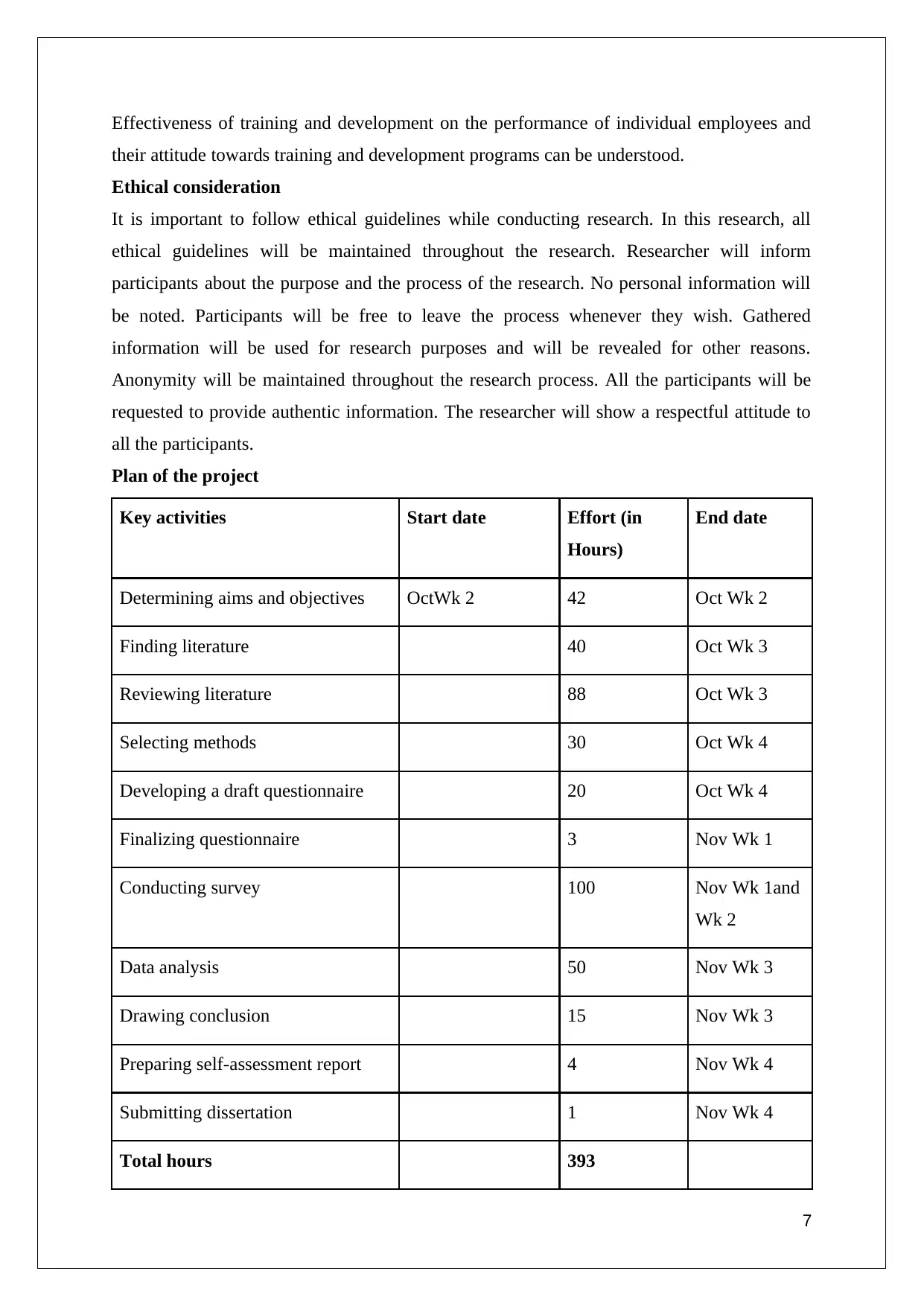
Effectiveness of training and development on the performance of individual employees and
their attitude towards training and development programs can be understood.
Ethical consideration
It is important to follow ethical guidelines while conducting research. In this research, all
ethical guidelines will be maintained throughout the research. Researcher will inform
participants about the purpose and the process of the research. No personal information will
be noted. Participants will be free to leave the process whenever they wish. Gathered
information will be used for research purposes and will be revealed for other reasons.
Anonymity will be maintained throughout the research process. All the participants will be
requested to provide authentic information. The researcher will show a respectful attitude to
all the participants.
Plan of the project
Key activities Start date Effort (in
Hours)
End date
Determining aims and objectives OctWk 2 42 Oct Wk 2
Finding literature 40 Oct Wk 3
Reviewing literature 88 Oct Wk 3
Selecting methods 30 Oct Wk 4
Developing a draft questionnaire 20 Oct Wk 4
Finalizing questionnaire 3 Nov Wk 1
Conducting survey 100 Nov Wk 1and
Wk 2
Data analysis 50 Nov Wk 3
Drawing conclusion 15 Nov Wk 3
Preparing self-assessment report 4 Nov Wk 4
Submitting dissertation 1 Nov Wk 4
Total hours 393
7
their attitude towards training and development programs can be understood.
Ethical consideration
It is important to follow ethical guidelines while conducting research. In this research, all
ethical guidelines will be maintained throughout the research. Researcher will inform
participants about the purpose and the process of the research. No personal information will
be noted. Participants will be free to leave the process whenever they wish. Gathered
information will be used for research purposes and will be revealed for other reasons.
Anonymity will be maintained throughout the research process. All the participants will be
requested to provide authentic information. The researcher will show a respectful attitude to
all the participants.
Plan of the project
Key activities Start date Effort (in
Hours)
End date
Determining aims and objectives OctWk 2 42 Oct Wk 2
Finding literature 40 Oct Wk 3
Reviewing literature 88 Oct Wk 3
Selecting methods 30 Oct Wk 4
Developing a draft questionnaire 20 Oct Wk 4
Finalizing questionnaire 3 Nov Wk 1
Conducting survey 100 Nov Wk 1and
Wk 2
Data analysis 50 Nov Wk 3
Drawing conclusion 15 Nov Wk 3
Preparing self-assessment report 4 Nov Wk 4
Submitting dissertation 1 Nov Wk 4
Total hours 393
7
Paraphrase This Document
Need a fresh take? Get an instant paraphrase of this document with our AI Paraphraser

8

Reference list
Bashir, N. and Long, C.S., 2015. The relationship between training and organizational
commitment among academicians in Malaysia. Journal of Management Development,
34(10), pp.1227-1245
bin Atan, J., Raghavan, S. and Mahmood, N.H.N., 2015. Impact of training on employees' job
performance: A case study of Malaysian small medium enterprise. Review of Management,
5(1/2), p.40..
Hee, O.C., Cheng, T.Y., Yaw, C.C., Gee, W.V., Kamaludin, S.M. and Prabhagaran, J.R.,
2016. The Influence of Human Resource Management Practices on Career Satisfaction:
Evidence from Malaysia. International Review of Management and Marketing, 6(3), pp.517-
521.
Nardi, P.M., 2018. Doing survey research: A guide to quantitative methods. Abingdon:
Routledge.
Zalaghi, H. and Khazaei, M., 2016. The role of deductive and inductive reasoning in
accounting research and standard setting. Asian Journal of Finance & Accounting, 8(1),
pp.23-37.
Saunders, B., Sim, J., Kingstone, T., Baker, S., Waterfield, J., Bartlam, B., Burroughs, H. and
Jinks, C., 2018. Saturation in qualitative research: exploring its conceptualization and
operationalization. Quality & Quantity, 52(4), pp.1893-1907.
Shafiq, S. and Hamza, S.M., 2017. The effect of training and development on employee
performance in private company Malaysia. International Journal of Education, Learning and
Training, 2(2).
Shah, S.H.A. and Beh, L.S., 2016. The impact of motivation enhancing practices and
mediating role of talent engagement on turnover intentions: Evidence from Malaysia.
International Review of Management and Marketing, 6(4), pp.823-835.
9
Bashir, N. and Long, C.S., 2015. The relationship between training and organizational
commitment among academicians in Malaysia. Journal of Management Development,
34(10), pp.1227-1245
bin Atan, J., Raghavan, S. and Mahmood, N.H.N., 2015. Impact of training on employees' job
performance: A case study of Malaysian small medium enterprise. Review of Management,
5(1/2), p.40..
Hee, O.C., Cheng, T.Y., Yaw, C.C., Gee, W.V., Kamaludin, S.M. and Prabhagaran, J.R.,
2016. The Influence of Human Resource Management Practices on Career Satisfaction:
Evidence from Malaysia. International Review of Management and Marketing, 6(3), pp.517-
521.
Nardi, P.M., 2018. Doing survey research: A guide to quantitative methods. Abingdon:
Routledge.
Zalaghi, H. and Khazaei, M., 2016. The role of deductive and inductive reasoning in
accounting research and standard setting. Asian Journal of Finance & Accounting, 8(1),
pp.23-37.
Saunders, B., Sim, J., Kingstone, T., Baker, S., Waterfield, J., Bartlam, B., Burroughs, H. and
Jinks, C., 2018. Saturation in qualitative research: exploring its conceptualization and
operationalization. Quality & Quantity, 52(4), pp.1893-1907.
Shafiq, S. and Hamza, S.M., 2017. The effect of training and development on employee
performance in private company Malaysia. International Journal of Education, Learning and
Training, 2(2).
Shah, S.H.A. and Beh, L.S., 2016. The impact of motivation enhancing practices and
mediating role of talent engagement on turnover intentions: Evidence from Malaysia.
International Review of Management and Marketing, 6(4), pp.823-835.
9
⊘ This is a preview!⊘
Do you want full access?
Subscribe today to unlock all pages.

Trusted by 1+ million students worldwide
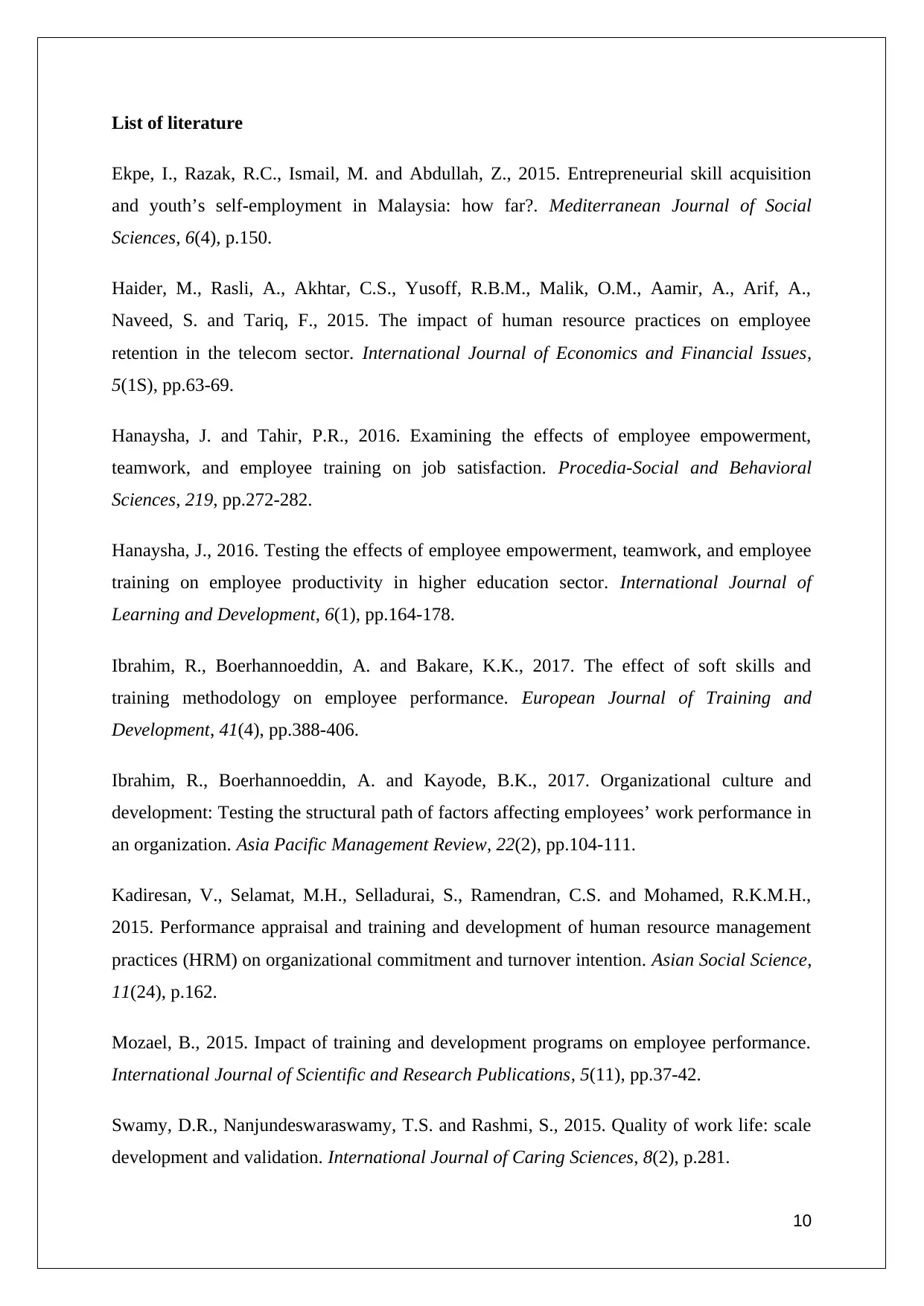
List of literature
Ekpe, I., Razak, R.C., Ismail, M. and Abdullah, Z., 2015. Entrepreneurial skill acquisition
and youth’s self-employment in Malaysia: how far?. Mediterranean Journal of Social
Sciences, 6(4), p.150.
Haider, M., Rasli, A., Akhtar, C.S., Yusoff, R.B.M., Malik, O.M., Aamir, A., Arif, A.,
Naveed, S. and Tariq, F., 2015. The impact of human resource practices on employee
retention in the telecom sector. International Journal of Economics and Financial Issues,
5(1S), pp.63-69.
Hanaysha, J. and Tahir, P.R., 2016. Examining the effects of employee empowerment,
teamwork, and employee training on job satisfaction. Procedia-Social and Behavioral
Sciences, 219, pp.272-282.
Hanaysha, J., 2016. Testing the effects of employee empowerment, teamwork, and employee
training on employee productivity in higher education sector. International Journal of
Learning and Development, 6(1), pp.164-178.
Ibrahim, R., Boerhannoeddin, A. and Bakare, K.K., 2017. The effect of soft skills and
training methodology on employee performance. European Journal of Training and
Development, 41(4), pp.388-406.
Ibrahim, R., Boerhannoeddin, A. and Kayode, B.K., 2017. Organizational culture and
development: Testing the structural path of factors affecting employees’ work performance in
an organization. Asia Pacific Management Review, 22(2), pp.104-111.
Kadiresan, V., Selamat, M.H., Selladurai, S., Ramendran, C.S. and Mohamed, R.K.M.H.,
2015. Performance appraisal and training and development of human resource management
practices (HRM) on organizational commitment and turnover intention. Asian Social Science,
11(24), p.162.
Mozael, B., 2015. Impact of training and development programs on employee performance.
International Journal of Scientific and Research Publications, 5(11), pp.37-42.
Swamy, D.R., Nanjundeswaraswamy, T.S. and Rashmi, S., 2015. Quality of work life: scale
development and validation. International Journal of Caring Sciences, 8(2), p.281.
10
Ekpe, I., Razak, R.C., Ismail, M. and Abdullah, Z., 2015. Entrepreneurial skill acquisition
and youth’s self-employment in Malaysia: how far?. Mediterranean Journal of Social
Sciences, 6(4), p.150.
Haider, M., Rasli, A., Akhtar, C.S., Yusoff, R.B.M., Malik, O.M., Aamir, A., Arif, A.,
Naveed, S. and Tariq, F., 2015. The impact of human resource practices on employee
retention in the telecom sector. International Journal of Economics and Financial Issues,
5(1S), pp.63-69.
Hanaysha, J. and Tahir, P.R., 2016. Examining the effects of employee empowerment,
teamwork, and employee training on job satisfaction. Procedia-Social and Behavioral
Sciences, 219, pp.272-282.
Hanaysha, J., 2016. Testing the effects of employee empowerment, teamwork, and employee
training on employee productivity in higher education sector. International Journal of
Learning and Development, 6(1), pp.164-178.
Ibrahim, R., Boerhannoeddin, A. and Bakare, K.K., 2017. The effect of soft skills and
training methodology on employee performance. European Journal of Training and
Development, 41(4), pp.388-406.
Ibrahim, R., Boerhannoeddin, A. and Kayode, B.K., 2017. Organizational culture and
development: Testing the structural path of factors affecting employees’ work performance in
an organization. Asia Pacific Management Review, 22(2), pp.104-111.
Kadiresan, V., Selamat, M.H., Selladurai, S., Ramendran, C.S. and Mohamed, R.K.M.H.,
2015. Performance appraisal and training and development of human resource management
practices (HRM) on organizational commitment and turnover intention. Asian Social Science,
11(24), p.162.
Mozael, B., 2015. Impact of training and development programs on employee performance.
International Journal of Scientific and Research Publications, 5(11), pp.37-42.
Swamy, D.R., Nanjundeswaraswamy, T.S. and Rashmi, S., 2015. Quality of work life: scale
development and validation. International Journal of Caring Sciences, 8(2), p.281.
10
Paraphrase This Document
Need a fresh take? Get an instant paraphrase of this document with our AI Paraphraser
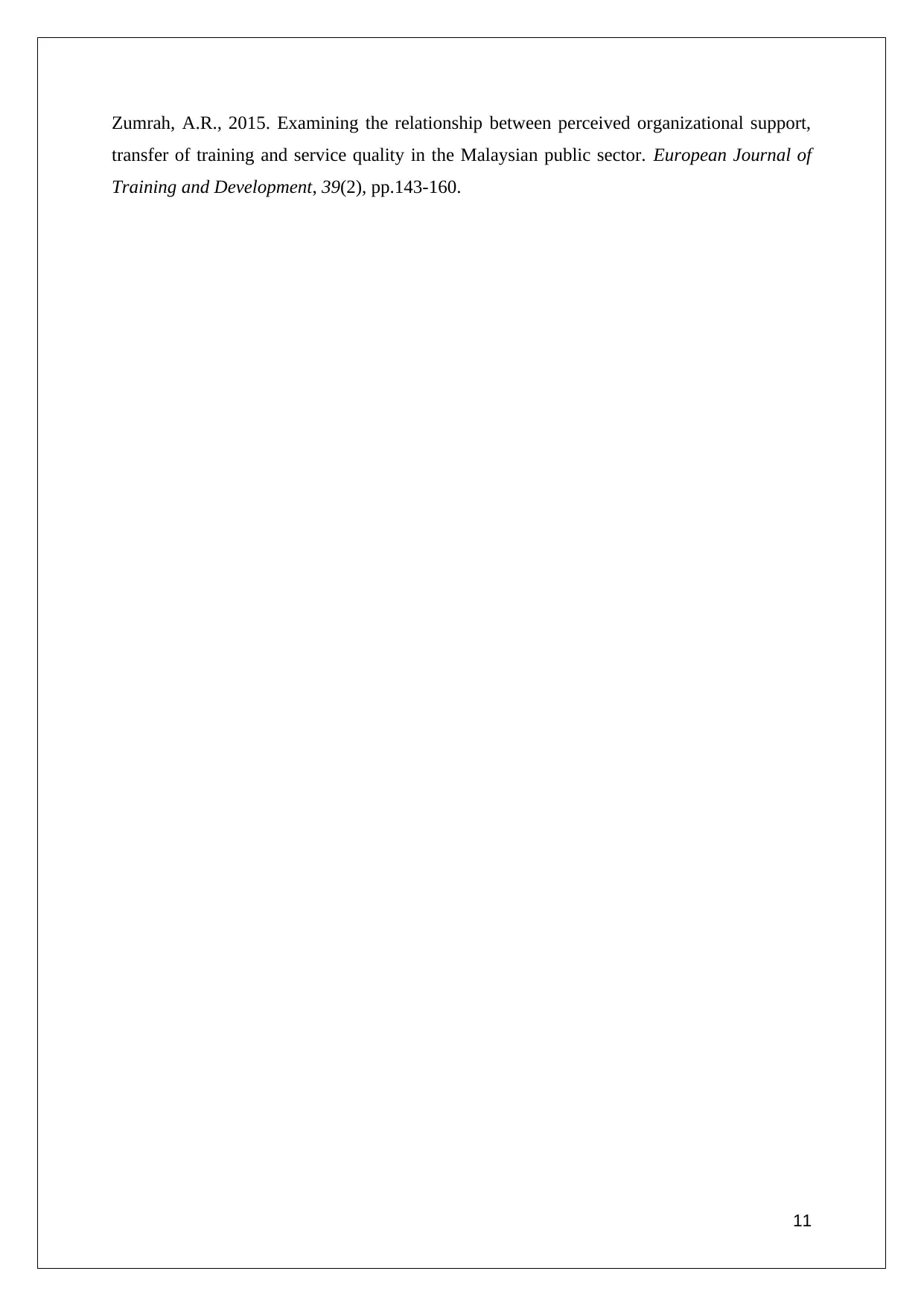
Zumrah, A.R., 2015. Examining the relationship between perceived organizational support,
transfer of training and service quality in the Malaysian public sector. European Journal of
Training and Development, 39(2), pp.143-160.
11
transfer of training and service quality in the Malaysian public sector. European Journal of
Training and Development, 39(2), pp.143-160.
11
1 out of 11
Related Documents
Your All-in-One AI-Powered Toolkit for Academic Success.
+13062052269
info@desklib.com
Available 24*7 on WhatsApp / Email
![[object Object]](/_next/static/media/star-bottom.7253800d.svg)
Unlock your academic potential
Copyright © 2020–2025 A2Z Services. All Rights Reserved. Developed and managed by ZUCOL.





